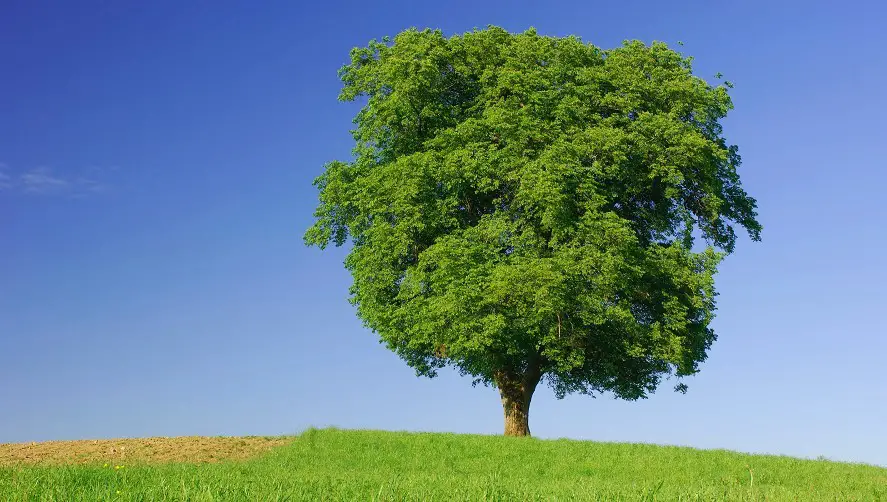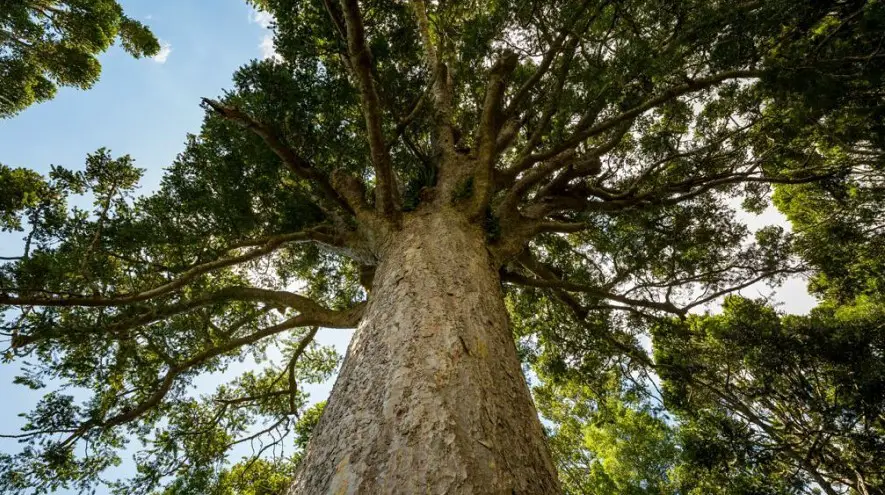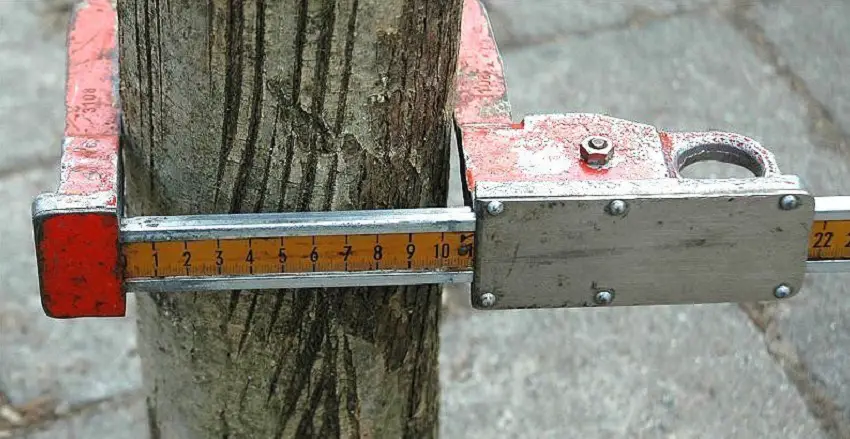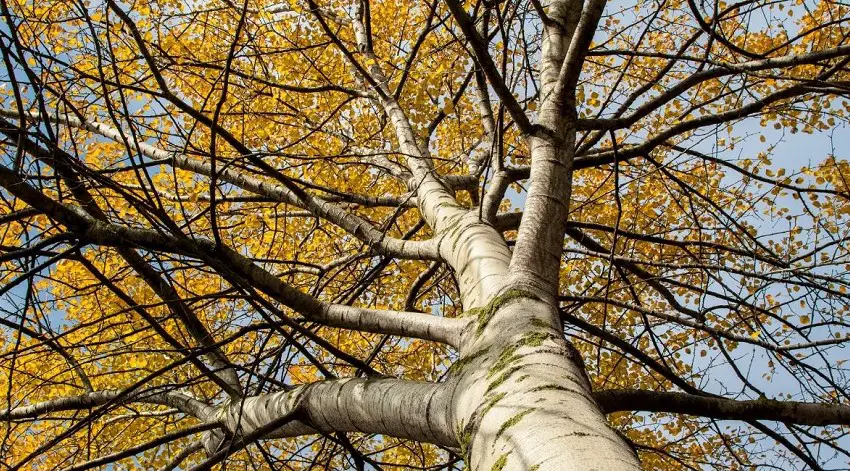Nothing else in nature appears to compare to the magnificence that trees possess. If you love or are curious about trees weigh, you might be interested in learning how much a tree weighs. We have done an extensive study on this issue and have some pertinent data on the weight of trees for you.

How do you determine a tree’s weight
A precise formula must be used to compute the weight of a tree. However, before we go into the method for calculating, let’s speak about the elements that determine tree weight.
You can count the number of leaves in a tiny sample to establish the precise weight of a tree without weighing it.
You may compute the total number of leaves on the tree using this number. Then divide the number of leaves by the total number of leafy branches on the entire tree.
To determine a tree weight, there are two common approaches. The first method involves suspending your tree from a scale and weighing it. The second way is easier, but it necessitates that you have a foundational understanding of measuring and numbers.
Some requirements
Here are the requirements if you wish to utilize a tape measure and calculator:
- A ruler or a tape measure
- A calculator (for people who struggle with math).
Calculation method for tree weight
Let’s examine the method for calculating tree weight. It may be determined using a rather straightforward method. It goes like this: leaf weight plus (volume x density).
As a result, to get a tree weight, multiply its volume by its density and then add the weight of its leaves to the result. Calculating tree weight is so simple.
How do I calculate tree weight?
The formula of calculating tree weight is:
(Volume x Density) + Leaf weight = Tree weight
This will enable you to calculate tree weight of your particular tree kind.

Factors that affect tree weight
Depending on the species, living trees can weigh anywhere from 1000 pounds to 2 million pounds. This is a relatively broad range because there are several factors that affect tree weight. Among these elements are:
- Diameter
- Tree height
- Hardwood or softwood
- Volume
- Density
- Leaves or no leaves
Trees develop throughout time, gaining weight and size as trees grow taller and wider.
Now that you know the range of weights that tree may reach and the variables that might impact that weight, you might be interested in learning how to compute tree weight. Continue reading to find out how to calculate a tree weight and what the heaviest tree is.
A tree with a diameter of 10 to 15 inches typically weighs 45 to 55 pounds. Living trees may weigh anything between 1,000 pounds and around 2 million pounds. This broad range is the consequence of several causes.
These variables include the tree’s height, diameter, kind of wood (hardwood or softwood), density, volume, and leafiness.
Other factors, such as tree kind and age, have a substantial influence on overall tree weight. I’ll go into great detail about how each of these elements impacts tree weight as well as how to calculate it

Diameter
Tree weight and tree diameter have a direct correlation. This implies that as tree diameter increases, so does tree weight.
For example, a hardwood tree with a 12 inch diameter weighs about 1500 pounds, whereas a hardwood tree with a 26 inch diameter weighs about 8400 pounds.
If you’re looking at two trees that are considerably different species in size, you can tell which one has the larger diameter.
There is a technique to ascertain the precise diameter, though, if you want to or need to do so in order to determine weight.
You must first estimate the circumference at breast height in order to determine a tree’s diameter. The breast height is around 55 inches above ground, and the circumference is the whole length of the tree’s curve. Therefore, you can simply measure the full curve length at a height of around 55 inches to get the circumference at breast height.
The circumference is the full curve length, and the breast height is around 55 inches above ground. A tape measurer is evidently necessary for measuring the tree. After determining the circumference at breast height, divide the circumference by pi to get the diameter at breast height (DBH).

Height
Like tree diameter and tree weight, tree height and weight have a direct impact on one another. As a result, taller trees tend to weigh more, while shorter trees tend to weigh less.
It could be challenging to really measure a tree’s height if you just want to see how tall it is. For accurate accurate estimates of the height of that particular tree, check the internet or a book. The main element that directly affects a tree weight is its height.
Trees that are taller tend to weigh more than those that are shorter. For example, a hardwood tree 80 feet tall weighs 18,000 pounds more than a pine tree 50 feet tall. However, this statement is not really accurate. Taller trees with proportionately greater diameters are heavier than shorter trees with wider girths.
If you have the correct tools, measuring a tree’s height is simple, and it’s an excellent place to start when estimating the weight of a tree.

Hardwood or softwood
A tree weight is considerably influenced by whether it is made of hardwood or softwood. Compared to softwood trees, hardwoods are heavier.
For instance, cypress trees are softwood trees, weighing around 32 pounds per cubic foot, compared to beech trees, which are trees and weigh about 45 pounds per cubic foot.
Softwood trees often weigh less than trees. Any tree that develops seeds with a cover on them that have the potential to grow into fruits or nuts is considered to be a hardwood tree.
The difference between hardwood and softwood
Softwood generate uncoated seeds that fall to the ground undeveloped, without developing into nuts or seeds. Compared to a softwood, a hardwood tree is heavier.
Consequently, a hardwood tree has a volume that is more than double that of a tree. A tree’s overall weight depends on the kind of wood it contains:
- A softwood tree often weighs less than a hardwood tree. Any tree that develops seeds with a coating on them that have the potential to grow into fruits or nuts is considered to be a hardwood tree.
- A softwood tree generates uncoated seeds that fall to the ground undeveloped and without developing into nuts or seeds.
For example, beech trees are hardwood trees, and cypress trees are softwood. Cypress trees only weigh 32 pounds per cubic foot.

Volume
The weight of a tree grows according to its volume. Volume plays a significant role in the formula used to calculate tree weight in addition to being a component that affects tree weight.
Volume is a direct factor determining tree weight. The main element in the calculation for tree weight is also volume. You may determine a tree weighs volume by looking at:
- its species
- age
- where it grows
Tree density
Density has a direct impact on tree weight, just as it does on diameter, height, and volume. Larger-density trees typically weigh more. So, if you want to determine how much a tree weighs, you must determine its density.
The percentage of a tree’s growth area that it occupies is referred to as the tree’s density. Based on canopy cover, the method used to determine tree density is the most popula
You may determine an approximation of a tree’s overall weight by calculating its tree weighs density.
There is a broad range for what trees can weigh.
Tree volume and tree density are multiplied, and leaf weight is added as the final step in the procedure for determining tree weight. If ever required, you should be able to calculate the weight of any tree using this method.
Based on canopy cover, the method used to determine tree density is the most popular. Again, giant sequoia density is inversely proportional to weight; thus, a heavier tree tends to be denser.
You may determine an approximation of a tree’s overall weight by calculating its tree density. You might not realize how much weight a tree’s leaves provide.
A giant sequoia
However, one of the most important factors influencing tree weight is leaves. The weight that leaves add to the tree is enormous.
Among the world’s heaviest trees, the giant sequoia is well recognized. The giant sequoia tree named General Sherman may be seen in Tulare County, California’s Sequoia National Park.
You must be wondering how much this enormous giant sequoia tree weighs to hold the distinction of being the biggest in the world.
Amazingly, the weight of the General Sherman tree is reported to be 2.7 million lbs (1.9 million KG). A giant sequoia is a fantastic tree.

Leaves or no leaves
The presence or absence of leaves has a significant impact on a tree weight. A tree weight is affected by the presence of leaves; when leaves are absent, the tree is lighter. For instance, magnolia trees contain a lot of leaves, which means that their weight significantly adds to the tree’s overall weight.
However, other factors trees, such as tamarisk trees, have little or no leaves. Because tamarisk trees have a small number of leaves, they are lighter than trees with many leaves, because fewer leaves mean fewer leaves to add to the overall weight of the tree. The method for estimating tree weight includes the weight of leaves, along with volume and density, as a key component.
The weight of leaves can be determined using two different methods. The first method is to take a tiny sample of leaves from the same tree you’re researching.
Next, ascertain how many leaves the tree has altogether.
The second option is to simply perform a search for the answer online or in a book to determine the weight of leaves. You might not realize that leaves significantly affect tree weight. However, one of the most important factors affecting tree weight is actually leaves. Leaves can influence tree weight.
Before presenting the method to compute tree weight, let’s first speak about the factors that influence tree weight. Tree weight and diameter have a direct correlation. As a result, a tree gains weight as its diameter grows.
Larger leaves—such as those on banana and coconut tree—are heavier than those on a tree with many smaller leaves. For example, magnolia trees produce a lot of leaves, which contribute significantly to the tree’s overall weight.
Tree species
When addressing the effect of species type on tree weight, the culmination of the aforementioned qualities becomes apparent. The species of the tree affects each of the aforementioned elements differently. Since each attribute can be expressed in a variety of ways, there is no quick way to determine weight.
The weight of a tree is the result of the complicated interaction of many different features.
The Giant Sequoia is the heaviest tree in the world, weighing 6,167 tons with a volume of 1,487 cubic meters and standing more than 300 feet tall.
Though the world’s lightest tree has not been officially identified, the balsa tree, whose wood is the lightest and softest available for commercial sale, is usually thought to be the lightest.
Final thoughts
Trees may weigh a broad range of things, and many different species things affect the weight of a tree. To calculate tree weight, multiply tree volume by tree density, then add leaf weight. Trees do not have a set weight. I wish you had more knowledge about the weight of trees after reading this post.
FAQ
How much does a tree normally weigh?
What is a tree’s weight? Given the wide range of sizes and tree species, this question is challenging to answer. A hardwood tree that is 24 inches in diameter and 80 feet tall would weigh around 20,000 pounds (9,072 kg).
The trees’ weight can range from 1000 to 2 meters. The weight of the tree can vary greatly based on a number of variables.
What’s the weight of a dead tree?
It is a tree that has already passed away but normally stays standing for a very long period of time. A standing dead tree will weigh virtually exactly the same as it did when it was living.
Trees’ capacity for retaining water varies, therefore some trees may lose weight quickly while others may do so more gradually. For instance, a living red oak tree weighs around 60 pounds per cubic foot (961 kg per cubic meter).
How do you calculate the weight of a tree?
Divide the volume and mass of the tree to determine its weight, and then add the weight of its leaves. It’s critical to comprehend the variations that affect tree weight.
How much does a 20 foot tree weigh?
Depending on the type and height of the tree, a 20-foot-tall tree might weigh anywhere from 300 to 600 pounds. The weight of a tree increases with its biomass, which increases with height.
Additionally, because they occupy more space in their surroundings than trees with upward-extending canopies, trees with an outwardly spreading canopy will weigh more.
How heavy is a large oak tree?
The strength and weight of oak trees have surely been mentioned before. Some of the most magnificent plants in the world are oak trees.
How heavy is a regular tree?
The weight of a tree is determined by its species and age. Trees get bigger and heavier as they age. You must know the tree height of a tree and diameter in order to calculate its weight.
How much does the heaviest tree weigh?
What is the heaviest tree in the world? And how much does a tree weigh? There are around 60,000 tree species recognized around the globe.
A Sequoia sempervirens tree in Redwood National Park holds the record for being the tallest tree in the world. For comparison, this gigantic tree is 1.25 times taller than the Statue of Liberty.
The 6,000-pound record-breaking tree was massive! Therefore, the biggest tree weighs almost as much as three automobiles. Two trees would soil moisture content be required to relocate your house if you were to do it with a truck. Trees may pull trains because they are so hefty soil moisture content.
What is the lightest tree in the world?
The Balsa Tree is a little further away from the time of General Sherman. Balsa trees are renowned for their light wood, even if it is not acknowledged as the lightest currently in use. Balsa wood has long been regarded as some of the lightest and softest commercially available balsa wood.
How heavy is a pine tree?
A pine tree typically weighs 10,000 pounds. Although pine trees typically grow to a tree height of 30 feet, some can reach 80 feet in tree height or be as small as 6 feet. The northern hemisphere is home to pine trees, which thrive in moderate settings with chilly winters. The oldest pine tree has been found to be more than 1,500 years old.
How much does a tree log weigh?
The weight of tree logs varies with volume and density. The beech tree weighed an estimated one foot in tree height and weighed 28 ounces on average.
Which tree contains wood that is the heaviest?
The biggest commonly traded wood, weighing 84.5 pounds (1 355 kg), is black ironwood.
Which tree has the thickest bark?
Giant sequoia has the thickest bark of any tree, in addition to being the heaviest. The bark’s outer layer often measures more than two feet thick at the tree’s base.
Which of these trees has a thick trunk?
Native to Africa, India, and Australia, baobab trees are distinguished by their very thick trunks. The trunk of a baobab tree may measure 82 feet in circumference and 29 feet in diameter.
How much does an average tree weigh?
This question is affected by a number of variables. The type of tree is the first consideration. Hardwood trees weigh more than softwood. The weight of a mature beech tree per cubic foot is 45 pounds. A juniper or cypress weighs around 20 pounds per cubic foot.





